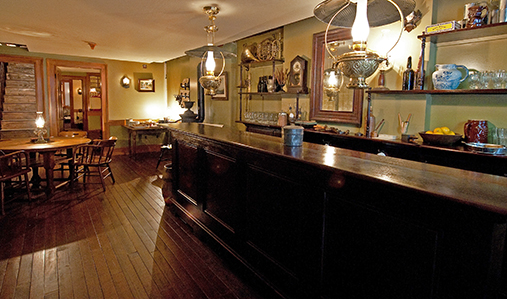I finally had a chance to take the new “Shop Life” tour at the always interesting Tenement Museum this past weekend. It shifts the story from the diverse lot of immigrant families that lived on the upper-floors to the long line of businesses that occupied the basement rooms at 97 Orchard Street. The poster below, a calculated bit of ‘pro-lager’ publicity mounted by German Americans against temperance advocates, now stands in the front window.

As this rather entertaining image suggests, the north half of the basement has been made up like a German saloon that was run by John and Caroline Schneider in the 1870s and 1880s. The interpretation centers on the role that beer saloons played in German immigrant life, and the room is neatly constructed and filled with period artifacts. The musical instruments hanging on the wall were interesting. I had not really thought that smaller saloons would feature live music, but it makes sense given the vibrancy of German musical culture (for those so inclined, Jessica Gienow-Hecht’s book Sound Diplomacy is an excellent study of music as an important avenue of cross-cultural exchange between the United States and Germany). A door at the back of the front saloon leads to the family’s living quarters, where the Schneiders, their son, and a serving girl resided. A nice touch is a faux membership certificate for the Improved Order of Red Men, which depending on your view was either a patriotic fraternal organization or a rowdy drinking club for working-class men. It was symbolic of the complex and ongoing negotiations that immigrants engaged in as they tried to preserve something of their culture and heritage while also adapting to American life.

The tour next heads into the other half of the basement, where museum workers discovered older living quarters and some twenty layers of wallpaper on the walls. We were shown some artifacts and a list of the dozens of businesses that occupied the building from 1863 through the 1980s, which ran the gamut from a butcher shop to a hosiery. The historical businesses were a fascinating index of the changing neighborhood, and this point was driven home during the final stop of the tour, one that I found particularly enlivening. After a short presentation, we were invited to pick objects from different eras off the store’s shelves and place them on a series of computerized tables with small handsets. The table then told the story of that particular object and provided interactive supplementary information in the form of historical photographs, sound and video clips, and the like. This was really cool I have to say. My object was a cocktail shaker from the 1930s when the space was occupied by a jobbing or auction house. Being able to handle the object myself really added something beyond the usual static physical and digital displays at museums. Moreover, the digital content was both good and easy to access. My only complaint would be that because of what I presume to be the technologically necessary texture on the table, the images were not of the highest resolution. While different institutions would obviously face a variety of different constraints, this system of allowing visitors to handle and learn about particular objects using a physical/digital interface seems like a very promising model for museums moving forward. In short, even if you are already familiar with the upstairs tours, the new “Shop Life” tour is well worth the visit.
